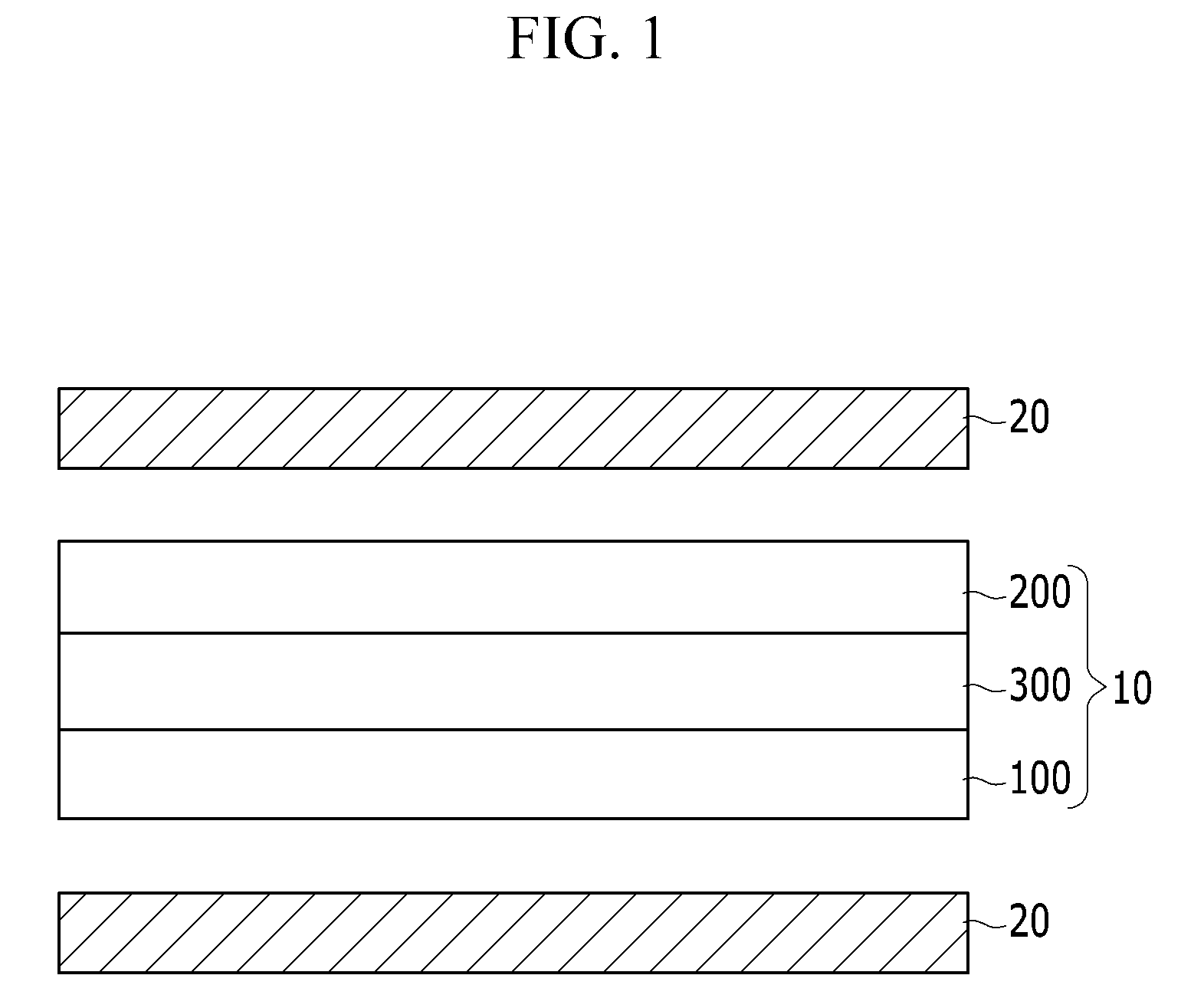Dichroic dye for use in polarizing film, polarizing film, and display device including the polarizing film
a technology of polarizing film and dye, which is applied in the direction of polarizing elements, lighting and heating apparatus, instruments, etc., can solve the problems of complex and expensive process, affecting the thickness of the display device, etc., and achieve the effect of improving the polarization properties
- Summary
- Abstract
- Description
- Claims
- Application Information
AI Technical Summary
Benefits of technology
Problems solved by technology
Method used
Image
Examples
synthesis example 1
[0114]2 g (6.32 mmol) of Disperse Yellow 7 is dissolved in 50 mL of acetone, and 1.1 mL (7.84 mol) of 1-bromohexane and 1.75 g (12.66 mmol) of potassium carbonate (K2CO3) are added thereto. The reaction mixture is agitated at 60° C. for 10 hours and cooled to room temperature. The resulting reactant is concentrated and then purified through silica gel column chromatography (CH2Cl2:n-hexane=2:1), preparing 2.38 g (5.94 mmol) of a dichroic dye represented by the following Chemical Formula 1aa. The dichroic dye has a yield of 94%.
[0115]The structure of the dichroic dye represented by the above Chemical Formula 1aa was confirmed by the 1H NMR analysis.
[0116]The 1H NMR analysis results are as follows.
[0117]1H NMR (300 MHz, CDCl3) δ (ppm): 0.94 (t, J=6.9 Hz, 3H, CH3), 1.35-1.40 (m, 4H, CH2×2), 1.49-1.56 (m, 2H, CH2), 1.82-1.88 (m, 2H, CH2), 2.31 (s, 3H, CH3), 4.07 (t, J=6.5 Hz, 2H, OCH2), 6.94 (d, J=8.3 Hz, 1H, ArH), 7.45-7.54 (m, 3H, ArH), 7.82-7.84 (m, 2H, ArH), 7.94-8.06 (m, 6H, ArH).
[...
synthesis example 2
[0119]1 g (3.16 mmol) of Disperse Yellow 7 is dissolved in 30 mL of acetone, and then 0.28 mL (3.75 mol) of bromoethane and 0.87 g (6.29 mmol) of potassium carbonate (K2CO3) are added thereto. The reaction mixture is agitated at 60° C. for 10 hours and cooled to room temperature. The resulting reactant is concentrated and then purified through silica gel column chromatography (CH2Cl2:n-hexane=2:1), preparing 1.05 g (3.05 mmol) of a dichroic dye represented by the following Chemical Formula 1ab. The dichroic dye has a yield of 97%.
[0120]The structure of the dichroic dye represented by the above Chemical Formula 1ab was confirmed by the 1H NMR analysis.
[0121]The 1H NMR analysis results are as follows.
[0122]1H NMR (300 MHz, CDCl3) δ (ppm): 1.48 (t, J=6.9 Hz, 3H, OCH2CH3), 2.31 (s, 3H, CH3), 4.13 (q, J=6.9 Hz, 2H, OCH2CH3), 6.93 (d, J=8.3 Hz, 1H, ArH), 7.46-7.54 (m, 3H, ArH), 7.81-7.84 (m, 2H, ArH), 7.94-8.07 (m, 6H, ArH).
[0123]The dichroic dye represented by the above Chemical Formula ...
example 1
[0129]A composition for a polarization film is prepared by mixing a polymer resin including polypropylene and a polypropylene-polyethylene copolymer in a weight ratio of 7:3 (w / w) and 0.5 parts by weight of the dichroic dye prepared according to Synthesis Example 1, based on 100 parts by weight of the polymer resin.
[0130]The composition for a polarization film is melt-blended at about 250° C. using a micro-compounder (made by DSM Co.). The melt-blended composition is put in a sheet-shaped mold and pressed at high temperature under high pressure to produce a film. Then, the film is 1000% elongated in one direction (using a tensile tester made by Instron Co.) at 125° C., to yield a polarization film.
PUM
| Property | Measurement | Unit |
|---|---|---|
| Percent by mass | aaaaa | aaaaa |
| Percent by mass | aaaaa | aaaaa |
| Efficiency | aaaaa | aaaaa |
Abstract
Description
Claims
Application Information
 Login to View More
Login to View More - R&D
- Intellectual Property
- Life Sciences
- Materials
- Tech Scout
- Unparalleled Data Quality
- Higher Quality Content
- 60% Fewer Hallucinations
Browse by: Latest US Patents, China's latest patents, Technical Efficacy Thesaurus, Application Domain, Technology Topic, Popular Technical Reports.
© 2025 PatSnap. All rights reserved.Legal|Privacy policy|Modern Slavery Act Transparency Statement|Sitemap|About US| Contact US: help@patsnap.com



